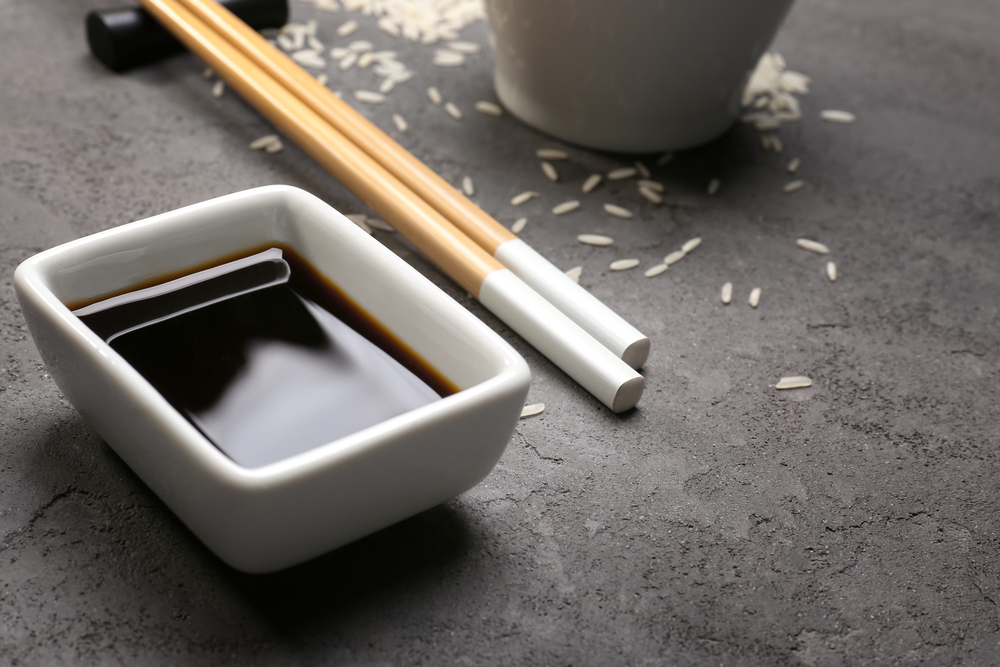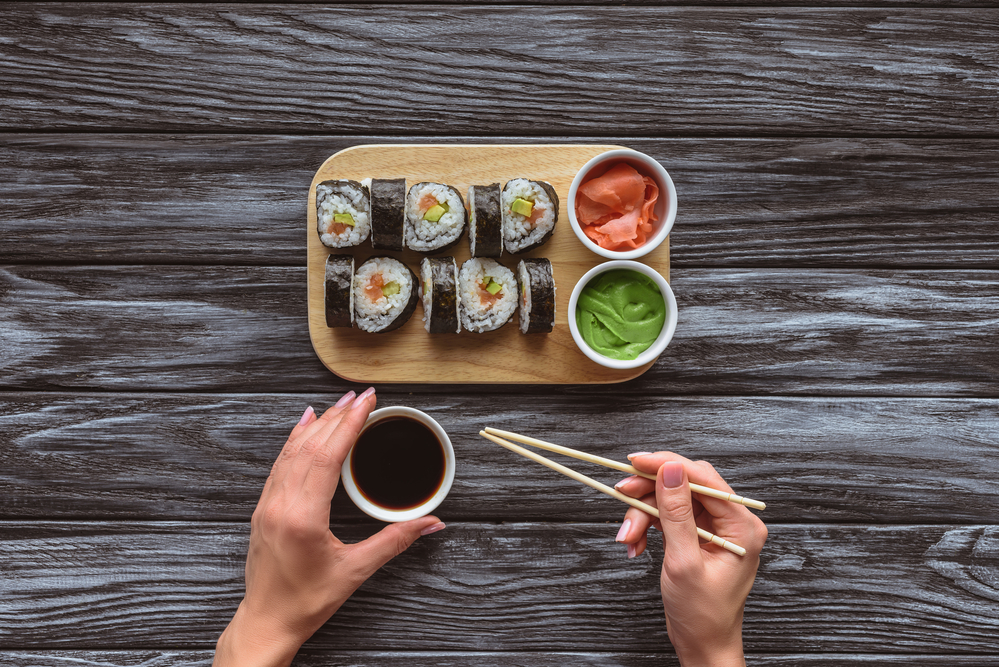- Home
- Blog
- Healthy Cooking
- How much sodium is in Asian salty sauces?
How much sodium is in Asian salty sauces?
Written by Catherine Saxelby
on Wednesday, 04 November 2020.
Tagged: health, healthy cooking, healthy eating, nutrition, salt

Salty sauces like soy, fish or hoisin sauce are a key feature of Asian cuisine and are used in countless ways as marinades, splashed into stir fries and soups, as a basting sauce on roasts and barbecues, as a dipping or a table sauce. These sauces are an easy way to add flavour to meats, fish, vegetables and plain rice or noodles. Their one drawback is the huge load of salt (sodium) they deliver. Read on for the best and worst of these sauces and how you can minimize their damage.
Most of these sauces are very low in fat and kilojoules (Calories). However, all tend to be high in salt which ranges from 3 to a whopping 20 per cent salt! This high salt content (combined with a low moisture content and often a high sugar content) gives them a long shelf life which means they can be stored unrefrigerated almost indefinitely. Even though the storage instruction say to refrigerate them after opening, honestly I’ve had some bottles in my kitchen for years and they’re fine. They take the place of the table salt in Western diets.
Eight types of Asian salty sauces
Of course, you’ll spot more than these eight, once you start adding in oil, chilli oil, rice wine and peppercorns, but these are the most popular sauces used by home cooks. There’s also teriyaki, sweet ‘n’ sour and ponzu sauces but these tend to be minor. The serve size varies from a small 10 mL, or 2 teaspoons, to a more standard 20 mL which equates to a tablespoon.
Soy sauce
This most popular of Asian sauces is essential to Chinese and Japanese cooking. It’s added to marinades, stir-fries, noodle dishes and used as a dipping sauce. In Indonesia, you’ll find Ketjap manis is a popular sweet soy sauce.
Gluten-free, wheat-free, tamari is one of the authentic sauces introduced to Japan from China. It is made from soy beans and has a slightly stronger flavour than regular soy sauce. It’s traditionally used to flavour longer-cooking foods such as soups and casseroles, but it can be used as a marinade or as a dipping sauce. Interestingly many soy sauces contain alcohol so if this is important to you then shop around, Ayam Light Soy and PureHarvest Organic Tamari are both alcohol and gluten free.
Fish sauce
Made by dissolving anchovies in salt over a long period of time, fish sauce loses its pungency when cooked or mixed with other ingredients. Used in Thai and Vietnamese dishes.

Oyster sauce
This sauce is made from oysters, soy sauce, salt and spices.
Chilli sauce
Comes in many variations e.g. sweet, hot and with garlic flavour. Can be added to soups, stir-fries and noodle dishes to add heat and enliven the flavour.
Black Bean
This sauce is made from fermented soy beans and adds a nutty barbecued flavour. Good for pork and chicken.
Hoisin Sauce
Made from soybeans, garlic, vinegar, sugar and spices, hoisin sauce has a sweet and spicy flavour. It can be added to a stir fry, used as a dipping sauce or to glaze a roast.
Satay sauce
This delicious sauce contains peanuts, coconut milk, chilli and spices. Traditionally it’s served as a dipping sauce with chicken skewers or to top an Indonesian Gado Gado salad.
Char Siu sauce
This is a pleasantly sweet and rich-tasting traditional Chinese-style barbecue sauce which gives pork that characteristic red glaze. 'Char Siu' in Cantonese means barbecued pork. This pork dish is a typical Cantonese delicacy.
Sodium (salt) in the 8 types of Asian sauces
|
Type of sauce |
Sodium (mg) per 100 g (or 100 mL) |
|
Soy sauce: average |
5965 |
|
Yeo’s Light Soy Sauce 640 mL |
8420 |
|
Lee Kum Kee Soy Sauce 150 mL |
8000 |
|
Yeo’s Dark Soy Sauce 640 mL |
7720 |
|
Fountain Soy Sauce 250 mL |
7200 |
|
Kikkoman Soy Sauce 600 mL |
6458 |
|
Kikkoman Soy Sauce Gluten Free 250 mL |
6365 |
|
Ayam Light Soy 210 mL |
6363 |
|
Pearl River Bridge Light Soy Sauce 500 mL |
5800 |
|
PureHarvest 250 mL |
5130 |
|
Lee Kum Kee Soy Sauce Reduced Salt 600 mL |
4000 |
|
Kikkoman Soy Sauce Salt Reduced 600 mL |
3560 |
|
ABC Sweet Soy Sauce 620 mL |
2130 |
|
Fish sauce: average |
7786 |
|
Squid Fish Sauce 300 mL |
11120 |
|
Ayam Fish Sauce 210 mL |
10882 |
|
Pandaroo Fish Sauce 200 mL |
8133 |
|
Chang’s Fish Sauce 300 mL |
7333 |
|
Maggi Fish Sauce 300 mL |
6180 |
|
Poonsin Fish Sauce 205 mL |
3065 |
|
Oyster sauce: average |
3463 |
|
Lee Kum Kee Panda Oyster Sauce 510 g |
4720 |
|
Coles Oyster Sauce 300 mL |
4400 |
|
Ayam Oyster Sauce 420 mL |
4100 |
|
Changs Oyster Sauce 430 mL |
4000 |
|
Maggi Oyster Sauce 295 mL |
3600 |
|
Ongs Oyster Sauce 255 g |
3111 |
|
Pandaroo Oyster Sauce 250 mL |
2200 |
|
Chilli sauce: average |
1618 |
|
Chang’s Hot Chilli Sauce 150 mL |
4150 |
|
ABC Extra Hot Chilli Sauce 340 mL |
2580 |
|
ABC Original Chilli Sauce 335 mL |
2500 |
|
Trident Hot Chilli Sauce 285 mL |
2070 |
|
Linghams Chilli Sauce 280 mL |
1260 |
|
Fountain Mild Chilli Sauce 250 mL |
1170 |
|
Fountain Hot Chilli sauce 250 mL |
1070 |
|
MasterFoods Squeezy Hot Chilli Sauce 250 mL |
934 |
|
Beerenberg Chilli Sauce 300 mL |
250 |
|
Black bean sauce: average |
2645 |
|
Ayam Black Bean Sauce 210 mL |
5573 |
|
Chang’s Black Bean Sauce 150 mL |
3400 |
|
Tyalor’s Stir Fry Black Bean Sauce 350 mL |
2950 |
|
KanTong Beef & Black Bean Cooking sauce 510 g |
799 |
|
Blue Dragon Stir Fry Black Bean Sauce 490 g |
496 |
|
Hoisin sauce: average |
2561 |
|
Woolworths Select Hoisin Sauce 320 mL |
4270 |
|
Chang’s Hoisin Sauce 150 mL |
3870 |
|
Lee Kum Kee Hoisin Sauce 240 g |
2750 |
|
Fountain Hoisin Sauce 250 mL |
2110 |
|
Ayam Hoisin Sauce 210 mL |
2089 |
|
Pandaroo Hoisin Sauce 250 mL |
1620 |
|
Ongs Hoisin sauce 227 g |
1220 |
|
Satay sauce: average |
992 |
|
Empower Foods LC Satay Sauce 350 mL |
1577 |
|
Fountain Satay Sauce 250 mL |
1310 |
|
Pandaroo Satay Sauce 250 mL |
773 |
|
Ayam Satay Mild Sauce 250 mL |
306 |
|
Char siu sauce: average |
NA |
|
Lee Kum Kee Char Siu Sauce 240 g |
4520 |
The bottom line
Which is the worst for salt? Take a look at the table where we have grouped these sauces into categories for you to compare – easily.
- If you’ve been told to reduce your salt intake, stick to a thin smear or a tiny side of your favourite – not a huge glug.
- Wherever you can, buy them in salt-reduced form. I know this is possible with soy sauce but not with the others. Your only other choice is to avoid really high-salt categories such as fish sauce.
- Buy those sauces with the lowest sodium content (sometimes there is a fourfold difference in sodium).
- When you use these sauces in a recipe, don’t add any more salt - it doesn’t need it.
Credit: Thanks to dietitian Marthury Jeyalingan for help compiling the table.
Foodwatch
The Good Stuff
The Boring Stuff
© 2025 Foodwatch Australia. All rights reserved
Website by Joomstore eCommerce






